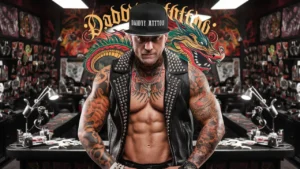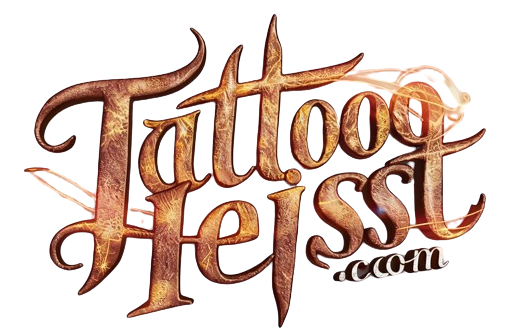Viking tattoos are a powerful way to connect with the rich history and mythology of the Norse warriors. These tattoos often feature symbols, gods, and designs that reflect the strength, courage, and mysticism of Viking culture.
In this article, we’ll explore 30 Viking tattoo ideas, each offering a unique perspective on Norse heritage.
We’ll delve into their designs, meanings, and ideal placements, helping you find the perfect tattoo to honor the Viking spirit.
1. Valknut Symbol
The Valknut, a symbol consisting of three interlocking triangles, is associated with Odin and the afterlife. It’s a powerful emblem of strength and connection to the gods.
Meaning and Placement
Meaning: Represents the bond between life and death, and the power of Odin. It symbolizes the transition to the afterlife and the warrior’s journey.
Placement: Ideal for the upper arm or chest, where the intricate design can be displayed prominently.
2. Yggdrasil Tree of Life
Yggdrasil, the World Tree, connects the nine realms of Norse mythology. A tattoo of this ancient tree reflects the interconnectedness of all life and the cosmic order.
Meaning and Placement
Meaning: Symbolizes the interconnectedness of all things, wisdom, and the balance of the cosmos. It’s a representation of the cycle of life and the connection to the divine.
Placement: Best suited for the back or full sleeve, allowing the detailed branches and roots to be fully appreciated.
3. Thor’s Hammer (Mjölnir)
Thor’s Hammer, Mjölnir, is a potent symbol of protection and power. This tattoo represents the strength of Thor and the ability to ward off evil.
Meaning and Placement
Meaning: Represents protection, strength, and divine power. It’s a symbol of defense against harm and the warrior’s resilience.
Placement: Ideal for the forearm or upper arm, where the hammer’s details can be showcased.
4. Odin’s Raven (Huginn and Muninn)
Odin’s ravens, Huginn and Muninn, symbolize thought and memory. A tattoo of these ravens reflects wisdom, intelligence, and the pursuit of knowledge.
Meaning and Placement
Meaning: Represents thought, memory, and the quest for wisdom. It signifies a deep connection to Odin and his quest for knowledge.
Placement: Best placed on the upper arm or back, where the ravens can be depicted in flight or perched.
5. Wolf of Fenrir
Fenrir, the monstrous wolf, is a symbol of chaos and destruction. A tattoo of Fenrir represents the power of primal forces and the struggle against destiny.
Meaning and Placement
Meaning: Symbolizes chaos, primal strength, and the struggle against fate. It reflects the untamed aspects of nature and the fight against inevitable outcomes.
Placement: Ideal for the upper arm or thigh, where the dynamic image of the wolf can be depicted in detail.
6. Viking Longship
A Viking longship tattoo reflects the adventurous spirit of the Norse seafarers and their journeys across the seas. It represents exploration and the quest for new horizons.
Meaning and Placement
Meaning: Represents exploration, adventure, and the warrior spirit of the Vikings. It’s a symbol of journeying into the unknown and conquering challenges.
Placement: Best suited for the forearm or side, allowing the ship and its sails to be depicted with detail.
7. Norse Runes
Norse runes are ancient symbols used for writing and divination. A tattoo featuring runes can reflect personal meanings or messages from Norse mythology.
Meaning and Placement
Meaning: Represents communication, magic, and ancient wisdom. Each rune has its own meaning and can be used to convey specific messages or attributes.
Placement: Ideal for the wrist or forearm, where individual runes or rune combinations can be displayed.
8. Viking Shield
A Viking shield tattoo symbolizes protection and honor. It reflects the warrior’s readiness to defend and the importance of valor in battle.
Meaning and Placement
Meaning: Represents protection, honor, and the warrior’s readiness for battle. It’s a symbol of defense and strength.
Placement: Best placed on the upper arm or back, where the shield’s details can be showcased.
9. Ragnarok Battle Scene
A tattoo depicting the battle of Ragnarok captures the epic clash between gods and giants. It represents the struggle between order and chaos.
Meaning and Placement
Meaning: Symbolizes the ultimate battle between good and evil, and the end of the world in Norse mythology. It reflects the struggle against overwhelming odds.
Placement: Ideal for the back or full sleeve, where the dramatic scene can be detailed and dynamic.
10. Viking Compass (Vegvísir)
The Vegvísir, or Viking compass, is a symbol of guidance and protection. It was believed to help Norse sailors navigate through difficult conditions.
Meaning and Placement
Meaning: Represents guidance, protection, and the ability to find one’s way through challenges. It’s a symbol of direction and safety.
Placement: Best suited for the forearm or wrist, where the intricate compass design can be displayed.
11. Helm of Awe (Aegishjalmur)
The Helm of Awe is a powerful protective symbol used by the Vikings. It was believed to instill fear in enemies and protect the wearer.
Meaning and Placement
Meaning: Represents protection, power, and intimidation. It’s a symbol of defense against enemies and the harnessing of fearsome energy.
Placement: Ideal for the upper arm or chest, where the symbol’s details can be prominently featured.
12. Norse Mythological Creatures
Tattoos featuring mythological creatures like Jörmungandr (the Midgard Serpent) or Surtur (the fire giant) bring to life the fantastical elements of Norse mythology.
Meaning and Placement
Meaning: Represents the mythical and powerful creatures of Norse legends. It reflects the awe-inspiring and fearsome aspects of Viking mythology.
Placement: Best placed on the back or full sleeve, where the creatures can be depicted in dynamic and detailed scenes.
13. Viking Berserker
A tattoo of a Viking berserker, known for their uncontrollable rage in battle, symbolizes raw power and fierce combat skills.
Meaning and Placement
Meaning: Represents uncontrollable rage, strength, and the primal aspect of the Viking warrior spirit. It reflects intense power and battle readiness.
Placement: Ideal for the upper arm or thigh, where the berserker’s dynamic pose and expression can be detailed.
14. Norse Gods
Tattoos featuring Norse gods like Odin, Thor, or Loki celebrate the powerful deities of Viking mythology. Each god has unique attributes and stories.
Meaning and Placement
Meaning: Represents the divine qualities and stories of Norse gods. It highlights personal connections to these legendary figures and their traits.
Placement: Best suited for the upper arm, back, or chest, where detailed images of the gods can be depicted.
15. Viking Knotwork
Intricate knotwork patterns are a staple of Viking art and symbolize eternity and the interconnectedness of life.
Meaning and Placement
Meaning: Represents eternity, interconnectedness, and the endless cycle of life. It reflects the continuity and unity of existence.
Placement: Ideal for the forearm or sleeve, where the intricate patterns can be showcased.
16. Runic Tree of Life
A runic version of Yggdrasil, incorporating Norse runes, symbolizes the cosmic tree and its connection to the realms of Norse mythology.
Meaning and Placement
Meaning: Represents the World Tree and its connection to all realms. It combines the symbolism of Yggdrasil with the power of Norse runes.
Placement: Best placed on the back or full sleeve, where the runes and tree can be depicted in detail.
17. Viking Helmets
A Viking helmet tattoo reflects the warrior’s readiness for battle and the iconic headgear of the Norse fighters.
Meaning and Placement
Meaning: Represents warrior spirit, readiness for battle, and the iconic symbolism of Viking helmets. It’s a symbol of courage and protection.
Placement: Ideal for the upper arm or chest, where the helmet’s details can be prominently displayed.
18. Norse Mythology Symbols
Incorporating various symbols from Norse mythology, such as the Tree of Life or the Wheel of Fate, celebrates the richness of Viking lore.
Meaning and Placement
Meaning: Represents the diverse symbols and stories of Norse mythology. It reflects a deep appreciation for Viking legends and their meanings.
Placement: Best suited for the forearm or side, where multiple symbols can be arranged in a cohesive design.
19. Viking Warrior with Sword
A tattoo of a Viking warrior wielding a sword captures the essence of Norse combat and valor. It symbolizes the bravery and skill of the ancient fighters.
Meaning and Placement
Meaning: Represents combat prowess, bravery, and the warrior spirit of the Vikings. It highlights the skill and honor of the Norse fighters.
Placement: Ideal for the upper arm or thigh, where the warrior’s dynamic pose and sword can be depicted in detail.
20. Thor’s Hammer with Runes
Combining Thor’s Hammer with Norse runes adds a layer of magical significance to the design, enhancing its protective and powerful attributes.
Meaning and Placement
Meaning: Represents protection and power, with the added mystical significance of runes. It highlights the strength of Thor and the magic of the runes.
Placement: Best placed on the forearm or upper arm, where the hammer and runes can be depicted together.
21. Viking Saga Scene
A tattoo depicting a scene from a Viking saga captures the epic tales of heroism and adventure from Norse literature.
Meaning and Placement
Meaning: Represents the heroic and adventurous tales of Viking sagas. It reflects a connection to the legendary stories of the Norse warriors.
Placement: Ideal for the back or full sleeve, where the scene can be depicted with intricate details.
22. Norse Valkyrie
A tattoo of a Valkyrie, the female warrior who chooses the slain, symbolizes bravery, destiny, and the guiding of souls to Valhalla.
Meaning and Placement
Meaning: Represents bravery, destiny, and the role of the Valkyries in guiding the worthy to Valhalla. It reflects a connection to the divine warriors of Norse mythology.
Placement: Best suited for the upper arm or side, where the Valkyrie’s detailed depiction can be appreciated.
23. Viking Serpent
A tattoo featuring a serpent, such as Jörmungandr, symbolizes the cosmic serpent and its role in Norse mythology.
Meaning and Placement
Meaning: Represents the cosmic serpent and its role in the destruction and rebirth of the world. It reflects the powerful and mythical aspects of Norse legends.
Placement: Ideal for the upper arm or thigh, where the serpent’s winding form can be depicted.
24. Runic Circle
A circle of runes symbolizes the cyclical nature of life and the interconnectedness of existence. It’s a powerful emblem of Norse wisdom and unity.
Meaning and Placement
Meaning: Represents the cyclical nature of life and the interconnectedness of all things. It reflects the wisdom and unity of Norse beliefs.
Placement: Best placed on the forearm or chest, where the circle of runes can be displayed.
25. Norse Shield Maiden
A tattoo of a shield maiden, a female warrior, celebrates the strength and valor of Viking women. It symbolizes gender equality and warrior spirit.
Meaning and Placement
Meaning: Represents the strength and valor of Viking shield maidens. It highlights the role of women in Norse warrior culture and their courage.
Placement: Ideal for the upper arm or thigh, where the shield maiden’s detailed armor and pose can be depicted.
26. Viking Battle Scene
A tattoo depicting a fierce Viking battle scene captures the intensity and chaos of Norse warfare. It reflects the warrior’s spirit and the struggle for glory.
Meaning and Placement
Meaning: Represents the intensity and chaos of Viking battles. It reflects the bravery and combat skills of the Norse warriors.
Placement: Best suited for the back or full sleeve, where the battle scene can be detailed and dynamic.
27. Thor’s Hammer with Dragon
Combining Thor’s Hammer with a dragon adds a mythical element to the design, symbolizing strength, protection, and the magical aspects of Norse lore.
Meaning and Placement
Meaning: Represents strength, protection, and the magical qualities of Norse mythology. It combines the power of Thor with the mythical dragon.
Placement: Ideal for the forearm or upper arm, where the hammer and dragon can be depicted together.
28. Norse Wolf Head
A tattoo of a wolf head, such as the one associated with Fenrir, symbolizes power, ferocity, and the primal aspects of Viking culture.
Meaning and Placement
Meaning: Represents power, ferocity, and the primal aspects of Norse culture. It reflects the untamed and fierce nature of the wolf.
Placement: Best placed on the upper arm or chest, where the wolf’s head can be detailed and prominent.
29. Runic Script
A tattoo featuring runic script, either in a message or phrase, connects with Norse language and magic. It reflects a personal connection to Norse culture.
Meaning and Placement
Meaning: Represents the Norse language and magical properties of runes. It allows for personalized messages or phrases in runic script.
Placement: Ideal for the wrist or forearm, where the script can be displayed and read easily.
30. Viking Sword and Shield
A tattoo of a Viking sword crossed with a shield symbolizes the warrior’s combat readiness and honor. It reflects the essential tools of a Norse fighter.
Meaning and Placement
Meaning: Represents combat readiness, honor, and the tools of a Viking warrior. It highlights the essential aspects of Viking warfare.
Placement: Best suited for the upper arm or back, where the sword and shield can be depicted in a balanced design.
Conclusion
Choosing a Viking tattoo is a powerful way to connect with Norse history, mythology, and warrior spirit. Whether you opt for symbols like Thor’s Hammer, mythical creatures, or detailed battle scenes, each design offers a unique way to honor the Viking legacy. Consider the meaning and placement of your tattoo carefully to ensure it resonates with your personal connection to Norse culture and reflects the strength and bravery of the ancient warriors.

I’m Justin Taylor, the force behind Tattoo Heist. With a profound passion for ink and a wealth of experience in the tattoo industry, I showcase exceptional tattoo artistry, share expert tips, and delve into the stories behind each design.





